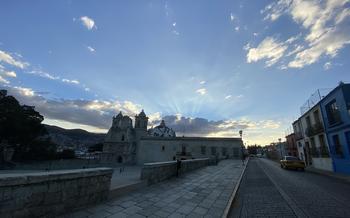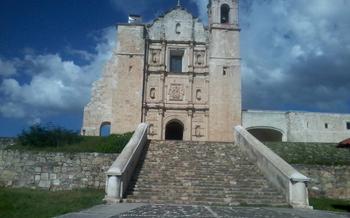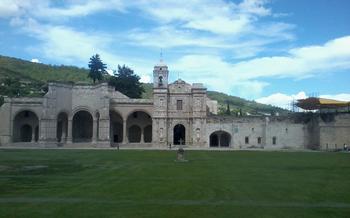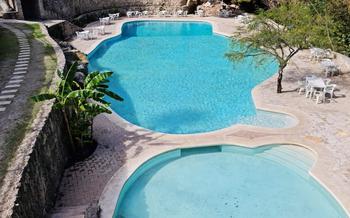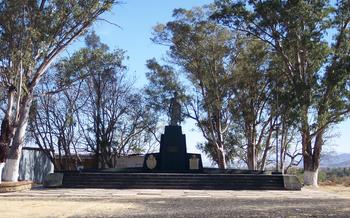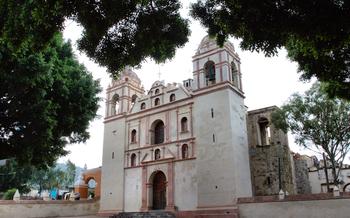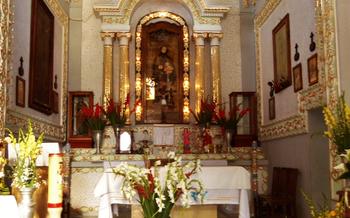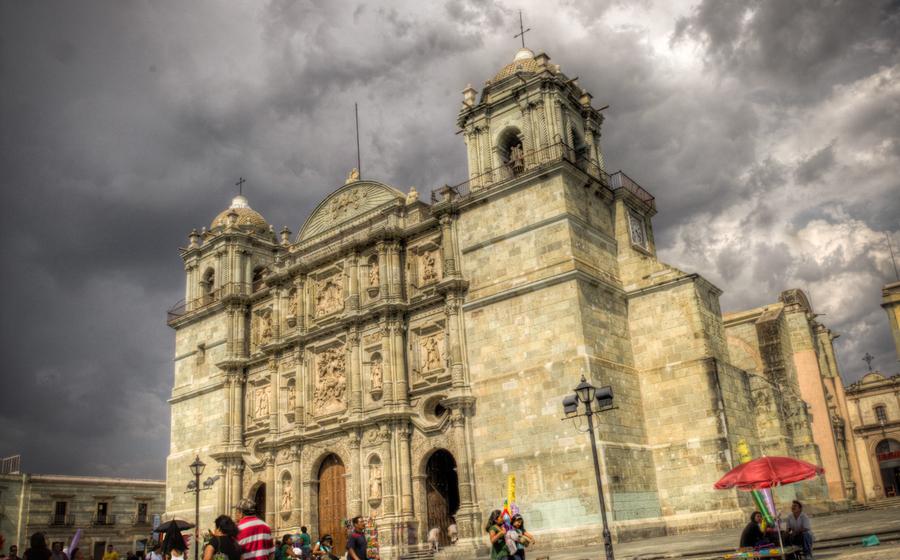
San Raymundo Jalpan
- Historical Significance
- Architectural Beauty
- Religious Significance
- Cultural Importance
- Guided Tours
- Exploring the Grounds
- Visiting the Museum
- Attending Mass or Services
- Photography Opportunities
- Surrounding Attractions
- Local Cuisine
- Handicrafts and Souvenirs: Preserving Cultural Heritage
- Getting There
- Practical Tips:
- Insider Tip: Experience the Monastery's Tranquility
Historical Significance
Explore the captivating history of the ancient Dominican monastery in San Raymundo Jalpan, Oaxaca. Delve into the tales of the Dominican friars who dedicated their lives to spreading Catholicism among the indigenous Zapotec community. Discover the monastery's role as a bridge between two distinct cultures, fostering religious harmony and cultural exchange. Unravel the stories of the Zapotec people, their traditions, and their interactions with the friars, gaining a profound understanding of the region's rich cultural tapestry.
Architectural Beauty
The architectural beauty of the San Raymundo Jalpan monastery is a testament to the fusion of Spanish and indigenous influences that shaped the region's cultural identity. Constructed in the Baroque style, the monastery's facade and interior are adorned with intricate carvings, sculptures, and murals that showcase the artistic prowess of the Dominican friars and local Zapotec craftsmen. The fusion of these two distinct styles is evident in the blend of European Baroque motifs with indigenous elements, creating a unique and harmonious aesthetic that has earned the monastery its designation as a UNESCO World Heritage Site.
The monastery's church is a masterpiece of Baroque architecture, with its ornate facade featuring columns, arches, and niches that frame the main entrance. The interior of the church is equally impressive, with its vaulted ceilings, elaborate altarpieces, and colorful murals that depict scenes from the Bible and the lives of the saints. The monastery's cloisters, with their arched walkways and tranquil gardens, provide a serene and contemplative space for visitors to reflect on the spiritual and cultural significance of this remarkable site.
Religious Significance
Immerse yourself in the spiritual atmosphere of the San Raymundo Jalpan Monastery, a place of worship and devotion for centuries. Learn about the Catholic traditions and rituals practiced within the monastery walls, and discover the stories of the saints and martyrs associated with the monastery and their significance to the local community. Experience the sense of serenity and peace that permeates the monastery's sacred spaces, and feel a connection to the faith that has sustained this holy place for generations.
Cultural Importance
The San Raymundo Jalpan Monastery holds immense cultural significance as a center of cultural exchange and learning where indigenous and Spanish cultures converged. This rich heritage is evident in the various cultural traditions and customs that have been preserved and celebrated within its walls. The indigenous Zapotec language, with its unique vocabulary and grammar, continues to be spoken and taught within the monastery, fostering a sense of cultural identity and continuity. Moreover, vibrant expressions of Zapotec art, music, and dance continue to thrive within the monastery's cultural sphere, showcasing the creativity and resilience of the indigenous community. The monastery serves as a living testament to the enduring legacy of cultural diversity and exchange that has shaped the region's cultural identity.
Guided Tours
To fully appreciate the rich history, architecture, and cultural significance of the San Raymundo Jalpan Monastery, consider taking advantage of the guided tours offered by knowledgeable local guides. These experienced guides will provide invaluable insights into the monastery's past, present, and ongoing role in the community.
During the tour, you'll learn about the legends and stories associated with the monastery, its construction, and its interactions with the indigenous Zapotec people. You'll have the opportunity to ask questions and engage in interactive discussions, deepening your understanding of this remarkable site.
Guided tours are available in various languages and can be tailored to fit different interests and time constraints. Whether you're a history buff, an architecture enthusiast, or simply curious about the cultural heritage of Oaxaca, there's a tour that's perfect for you.
So, embrace the opportunity to explore the San Raymundo Jalpan Monastery with a knowledgeable guide, and discover the hidden treasures and stories that make this UNESCO World Heritage Site so captivating.
Exploring the Grounds
Stroll through the monastery's enchanting gardens, where vibrant flowers, fragrant plants, and towering trees create a serene and tranquil atmosphere. Discover hidden corners, courtyards, and fountains that offer unique perspectives and photo opportunities. Relax on benches or in shaded areas and soak in the beauty of the natural surroundings. Enjoy the tranquility and escape the hustle and bustle of the city. As you wander through the gardens, imagine the Dominican friars tending to their plants, seeking solace and inspiration in nature's embrace. Let the beauty of the gardens transport you to a time of peace and contemplation, where the worries of the world melt away.
Visiting the Museum
The on-site museum at the San Raymundo Jalpan monastery is a treasure trove of historical artifacts, paintings, sculptures, and religious objects that provide a deeper glimpse into the monastery's rich past. Visitors can learn about the lives of the Dominican friars and their interactions with the indigenous Zapotec community, as well as discover the artistic and cultural treasures that have been preserved within the monastery walls. The museum offers a unique opportunity to gain a deeper understanding of the region's cultural heritage and its enduring legacy.
Attending Mass or Services
Immerse yourself in the spiritual atmosphere of the San Raymundo Jalpan Monastery by attending mass or other religious services held within the church. Witness the traditions and rituals of the Catholic faith as practiced by the local community. Listen to the melodious chanting, watch the colorful processions, and participate in the communal prayers. Feel a sense of connection to the faith and the community that has sustained the monastery for centuries. Experience the tranquility and peace that permeate the monastery's sacred spaces and let the spiritual energy wash over you. Whether you are a devout Catholic or simply seeking a deeper connection with your spirituality, attending mass or services at the San Raymundo Jalpan Monastery is an enriching and transformative experience.
Photography Opportunities
The San Raymundo Jalpan Monastery offers a wealth of photography opportunities for enthusiasts and casual photographers alike. Capture the stunning beauty of the monastery's Baroque-style architecture, with its intricate carvings, sculptures, and murals, against the backdrop of the surrounding mountains. Explore the lush gardens, with their vibrant flowers and towering trees, and discover hidden corners and courtyards that offer unique perspectives.
Take advantage of the natural light that illuminates the monastery at different times of the day, creating dramatic shadows and warm glows. Experiment with different angles and perspectives to create unique and memorable shots.
Don't miss the opportunity to capture the monastery's serene atmosphere and the spiritual essence that permeates the air. Share your photos with friends, family, and fellow travelers to spread the word about this hidden gem and inspire others to explore the rich cultural heritage of Oaxaca.
Surrounding Attractions
Don't limit your exploration to just the monastery; venture beyond its walls to discover the region's rich cultural heritage and natural beauty. A short distance away lies the ancient Zapotec city of Monte Albán, a UNESCO World Heritage Site that offers a glimpse into the pre-Columbian past of Oaxaca. Marvel at the well-preserved ruins, including pyramids, plazas, and ball courts, and immerse yourself in the history of this once-powerful civilization.
Another must-see attraction is the Tule Tree, the world's stoutest tree with a trunk circumference of over 58 feet. Witness the grandeur of this natural wonder and learn about its cultural significance to the local Zapotec people. For those interested in botany and ecology, the Ethnobotanical Garden of Oaxaca is a treasure trove of native plants, offering insights into the region's diverse flora and its traditional uses in medicine and cuisine.
By exploring these surrounding attractions, you'll gain a deeper understanding of Oaxaca's rich cultural tapestry and the natural wonders that make this region so captivating.
Local Cuisine
Oaxaca's cuisine is a culinary delight, bursting with bold flavors, fresh ingredients, and unique dishes that tantalize the taste buds. Indulge in traditional delicacies such as mole, a rich and complex sauce made with various chilies, nuts, and spices, often served with chicken or pork. Savor tlayudas, large, crispy tortillas topped with beans, cheese, meat, and vegetables, a popular street food. Don't miss the tamales, steamed cornmeal dough filled with savory fillings like chicken, pork, or vegetables, wrapped in banana leaves.
To fully experience Oaxaca's culinary scene, visit local markets and restaurants. Browse the vibrant stalls in the bustling markets, where vendors sell fresh produce, aromatic spices, and handmade tortillas. Engage with the friendly locals, learn about the history and cultural significance of Oaxacan cuisine, and sample the delicious offerings.
Support the local economy and take home a taste of Oaxaca by purchasing handicrafts and souvenirs. Discover colorful textiles, intricate pottery, and hand-carved wooden crafts made by skilled artisans. Each piece is a unique expression of the region's rich artistic traditions. Visit artisan workshops and galleries to witness the creative process and learn about the techniques used by local craftspeople. Your purchases not only support the local economy but also serve as cherished reminders of your time in Oaxaca.
Handicrafts and Souvenirs: Preserving Cultural Heritage
Immerse yourself in the vibrant world of Oaxacan handicrafts and discover the region's rich artistic traditions. Explore local markets and shops to find colorful textiles, intricate pottery, and hand-carved wooden crafts made by skilled artisans. Each piece is a testament to the creativity and cultural heritage of the region. Support the local economy by purchasing these unique souvenirs and take home a piece of Oaxaca's charm.
Visit artisan workshops and galleries to witness the creative process firsthand and learn about the techniques used by local craftspeople. Observe the intricate weaving of Zapotec textiles, the delicate molding of clay into pottery, and the skillful carving of wood into intricate designs. Engage with the artisans and learn about the stories and inspirations behind their work.
By purchasing handicrafts and souvenirs, you not only support the local economy but also contribute to the preservation of Oaxaca's cultural heritage. These beautiful creations are a tangible reminder of the region's vibrant traditions and the creativity of its people.
Getting There
To reach the monastery, located about 10 kilometers from the city of Oaxaca, you have several transportation options. Renting a car or taking a taxi is a convenient choice, allowing you to travel directly to the monastery. Alternatively, embrace the local experience by taking a local bus or colectivo from the city center. These affordable options offer a chance to interact with locals and enjoy the scenic countryside views as you make your way to the monastery. Whichever mode of transport you choose, the journey promises to be a memorable part of your visit to this hidden gem.
Practical Tips:
When planning your visit to the San Raymundo Jalpan Monastery, keep these practical tips in mind to ensure a smooth and enjoyable experience:
Timing is Key: Aim to visit the monastery during the dry season, which runs from November to April, to avoid the heavy rains that can disrupt your exploration.
Comfortable Footwear: Wear comfortable shoes, as you will be doing a lot of walking on uneven surfaces within the monastery grounds.
Capture the Beauty: Bring a camera to capture the stunning beauty of the monastery's architecture, gardens, and surroundings.
Respect the Sacred Space: Remember that the monastery is a religious site. Dress appropriately and maintain silence during mass or other religious services to show respect for the spiritual atmosphere.
Insider Tip: Experience the Monastery's Tranquility
For an unforgettable experience, visit the monastery either early in the morning or late in the afternoon. During these less crowded hours, you'll have the opportunity to fully immerse yourself in the monastery's serene atmosphere. Take your time to wander through the gardens, admire the intricate architecture, and soak in the tranquility of this sacred space. You'll have the chance to truly appreciate the monastery's beauty and spiritual significance without the distractions of large crowds.
